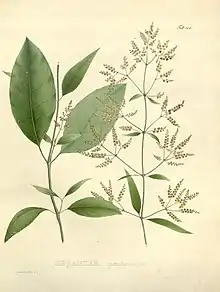Hebanthe eriantha
Hebanthe eriantha (Pfaffia paniculata, suma, or Brazilian ginseng) is a species of plant in the family Amaranthaceae.
| Suma | |
|---|---|
 | |
| Scientific classification | |
| Kingdom: | |
| (unranked): | |
| (unranked): | |
| (unranked): | |
| Order: | |
| Family: | |
| Genus: | |
| Species: | H. eriantha |
| Binomial name | |
| Hebanthe eriantha (Poir.) Pedersen | |
| Synonyms | |
The root of this rambling ground vine found in South America is used traditionally as a medicine and tonic. Nicknamed "para tudo" which means "for all," suma is a traditional herbal medicine.[1] The indigenous peoples of the Amazon region have used suma root for generations for a wide variety of health purposes, including as a general tonic; as an energy, rejuvenating, and sexual tonic; a calming agent; to treat ulcers; and as a cure-all for at least 300 years.[2]
The root contains phytochemicals including saponins (pfaffosides),[3] pfaffic acid, beta-ecdysterone, glycosides, and nortriterpenes.[2]
References
- Vieira, Roberto F. (1999) Conservation of medicinal and aromatic plants in Brazil. p. 152–159. In: J. Janick (ed.), Perspectives on new crops and new uses. ASHS Press, Alexandria, VA.
- Leslie Taylor (2005). "The Healing Power of Rainforest Herbs". Tropical Plants Database.
- "Triterpenoids from Brazilian Ginseng, Pfaffia paniculata" Jing Li, Atul N. Jadhav, Ikhlas A. Khan Tropical Plant Database Archived May 9, 2007, at the Wayback Machine
This article is issued from Wikipedia. The text is licensed under Creative Commons - Attribution - Sharealike. Additional terms may apply for the media files.